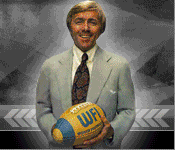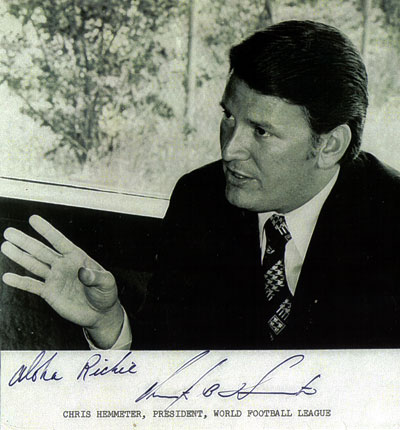


-
WFL

-
1974 Season

-
1975 Season

-
Multimedia


WFL Hemmeter Plan

The World Football League's Hemmeter Plan is designed to revolutionize the industry of professional sports.
"Revolutionary" is what Southern California Sun head coach Tom Fears, a veteran of 24 years as a player and coach in the NFL, terms the plan named after its author and the president of the new league, Chris Hemmeter.
What is new in the WFL in 1975 is the idea of paying player salaries based on a percentage of revenues. The average salary in the WFL this season will be one percent of a team's income after taxes. WFL team incomes in 1974 ranged between $1.1 and $2.85 million. With gate sharing, they should be grouped much closer together in 1975. If a team this year takes in $2 million, its average player would earn $20,000. On the other hand, if WFL teams earned the $7 million that many NFL teams did last year, the average player would earn a whopping $70,000 a year. WFL teams need only earn half as much as NFL clubs for the average WFL salary to equal the average NFL salary.
The important fact to understand is that a team will only be paying its players in relation to the money it takes in. If a team wishes to pay a player more money than it can account for through percentages, it must escrow the extra money in advance. By paying players on this basis, WFL teams will always be assured of meeting their payrolls. Perhaps more importantly, WFL players will be earning a share of their team's business and consequently will take greater interest in the success, financial as well as competitive, of their team.
What follows is a more detailed explanation of the workings of the Hemmeter Plan. It is lengthy, but a reading of it should better assist you in understanding why the WFL is unique from any previous league in any sport. The success of this new approach to a professional league is the true excitement of the World Football League in 1975.
The basic idea behind the Hemmeter Plan is to make as many of a team's costs as possible "variable costs," or costs which vary directly in relation to that team's revenues. As an example, if Company A agrees to pay Company B ten percent of its revenues for some service, then the amount of money Company A pays out varies directly with the amount of money it takes in. If Company A makes a lot of money, both it and Company B make a lot. If it makes no money at all, both it and Company B get nothing. The important point to understand, however, is that if Company A takes in no money, it does not owe Company B any. On the other hand, if Company A had agreed to pay Company B a flat sum, say $10,000, for the service, it would have to pay out that $10,000 regardless of the fact that it had made no money.
Obviously, the best way to guarantee that your company never had any losses would be to put all expenses on a variable base. That is virtually impossible, of course, but the closer one can come to it, the less one risks losing. In the case of the World Football League, the Hemmeter Plan calls for making players' and coaches' salaries, stadium rentals and league assessments variable costs. The Hemmeter Plan allocates 42% to salaries, 3% to an injured reserve pool, 10% to stadiums and 6% to the league.
That leaves approximately 39% of revenues which can be applied toward those areas where percentages cannot be used, such as office rent, front office salaries, telephone and telegraph costs, and so forth. By strict budgeting, the Hemmeter Plan has set a ceiling on those costs of $650,000.
By setting these guidelines, the Hemmeter Plan has made it possible for the World Football League to operate as a responsible financial entity in 1975. $650,000 is roughly 39% of $1.7 million (more like $663,000). That means a team can break even if it earns that amount since it will be able to pay all its fixed costs. As a safeguard, the Hemmeter Plan has required that all teams participating in the league this year place $545,000 in a working capital account before the season begins. Even if the league averages only half the paid attendance it did in 1974, the $545,000 will allow teams to cover all their fixed costs for three years.
Under the Hemmeter Plan, there will basically be three types of player contracts. The first will be on a straight percentage basis. and since there are roughly 42 coaches and players and 42% allocated to salary, the average contract will call for one percent. The second type of contract calls for a percentage and a fixed amount, say one percent plus $10,000. In this case, the team must escrow the $10,000 in advance. Lastly, there is a contract for a fixed amount. Each team in the league has been given a conservative estimate of its revenues which it can apply against a fixed contract. For instance, if a team's estimate is $1.5 million and a player asks for $25,000, the team can allocate one percent to that player ($15,000) and only be required to escrow the remaining $10,000. The team can allocate the entire amount to percentages or put it all in an escrow account, but in no case can the total number of percentage points given out surpass the 42 permitted. With these safeguards, all contracts will be honored.
As a backup for the Hemmeter Plan, the World Football League has hired the national accounting firm of Haskins and Sells. Bookkeeping on every team will be done in the exact same manner and a representative from Haskins and Sells will visit each team every week to review the books. Each team will have several bank accounts, including one each for coaches' and players' salaries, stadium rental, league assessments and operating expenses. Money will be deposited into each of these accounts following each game. Any team wishing to draw money from any account other than the one for operating expenses must get league sanction for the release of the funds. In this manner, the league guarantees a just accounting for everyone being paid on a percentage basis and also guarantees that the Hemmeter Plan be followed in every last detail.
© 1996-2007 Robert Phillips. All rights reserved.
© Copyright 1996-2007 Robert Phillips, All Rights Reserved